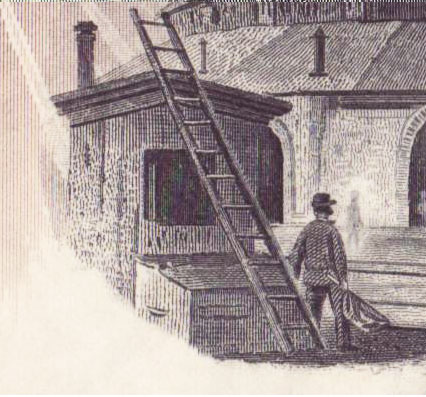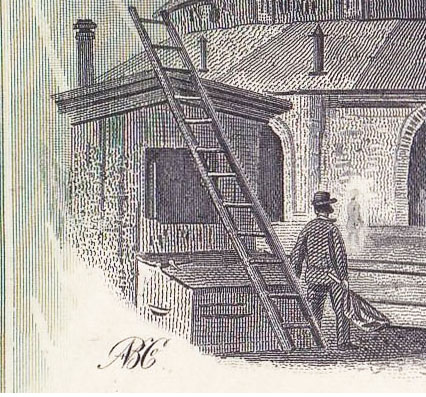Obscure valuable variety or worthless "flyspeck?"
Collectors often want to know whether isome minor feature rises to a sufficient level of importance to qualify as a new sub-variety. I show one such example below.
The illustration at right comes from two versions of stock certificates printed by Franklin Bank Note Company and issued by the Missouri Kansas & Texas Railway Company. Note the addition of the ABNCo logo on the right. Is this "flyspeck" variation worthy of a separate catalog number?

Version used 1891 to 1907
|

Version used 1905-1923
|
The general layout and composition of the certificates is identical. Both versions are known with 12 lines of text. In later years, text on the logo version was shortened to 8 lines. Preferred certificates (with different vignettes) also show the similar changes with both logo and text. I do not have records of a large number of serial numbers for either version, the one with the logo is probably somewhat more common, mainly because of its longer period of use. Price records with both the common and preferred certificates prove that collectors value them similarly.
In addition to the ABNCo logo and differences in the number of lines of text, there are easily-overlooked differences in border designs between the various denominations. (Note differences in the "sunrays" coming from the top left. The brown version (left vignette) is a 10-share example and the green version is a 100-share.)
So, why the logo?
While admittedly a VERY minor feature, the ABNCo logo was important because it signaled the consolidation of Franklin Bank Note Company into American Bank Note Company in 1907. It is for that reason alone that I decided to assign a sub-variety number to THAT particular "flyspeck" variation.
However, if we really wanted to venture even "deeper into the weeds," there are more highly subtle differences in the engraved black portions of certificates: differences in placement of the ABNCo logo; differences in the clouds; differences in shapes and positions of "swooshes" around the company name. While features like that have attracted collector interest in the stamp and paper money hobbies, that is NOT THE CASE in scripophily.
Why not create listings for ALL the minor variations the collectors find?
Two constraints govern the number of varieties I catalog:
- Lack of time.
- Absence of price justification.
In truth, there is little challenge in finding small differences among near-identical certificates. Minor adjustments to text were common. I suspect most changes were accomplished when companies ordered new groups of certificates. Printing plates sometimes needed "touch-ups" because of wear and mis-handling. Each gave rise to minor, but identifiable, variations. Collectors frequently report minor differences thinking I am always trying to create new sub-varieties. In fact, the opposite is the case. I try to avoid adding new minor sub-varieties because of several realities.
- This project consists of almost 24,000 varieties and sub-varieties of certificates and and the number climbs. When coupled with rarity, that number is multiples of what any wealthy collector could assemble in a lifetime.
- Dealers do not describe and list minor variations. They have no economic incentive.
- High estimates of the number of stock and bond collectors exist, but only a fraction of those actively collect North American railroad certificates. I suspect that number is below 2,000 collectors on both sides of the Atlantic Ocean. Even if we double that estimate, the number actively collecting in any particular specialty is tiny.
- The number of participants attracted to any particular variety of railroad certificate at any one time is small. For proof, one needs to look only at the number of bidders for any average railroad stock or bond sold on eBay.
- The high number of identified varieties combined with restricted numbers of hobbyists suggests there is limited demand for hardly any sub-variety. The demand for every new sub-variety only diminishes.
Price history CLEARLY suggests that collectors are currently unwilling to pay for flyspeck varieties.
What about recording company presidents?
A few collectors have suggested I record the names of company president who signed certificates. Even if I had the time, presidential signatures are terribly hard to read and the majority cannot be discovered even through research.
Ignoring that limitation for the moment, we can calculate that if only a quarter of the issued stock certificates showed two presidential names and none of the bonds or other certificates showed any multiples, we would increase the number of collecting choices by about 1,400 or about 6%. That is not a lot. The problem is not the raw numbers of possible additions, but the number of collectors. Until the number of collectors increases tremendously and several thousand of them become interested in collecting railroad company presidents, there will never be any measurable effect on prices.
In short, the total lack of effect on prices precludes including flyspeck variations unless they accompany additional – and visible – differences.